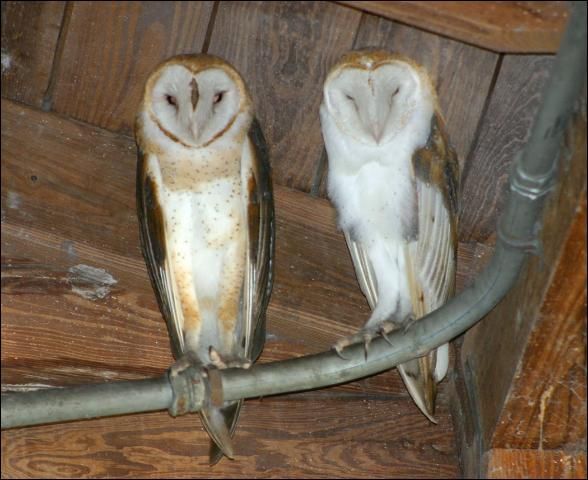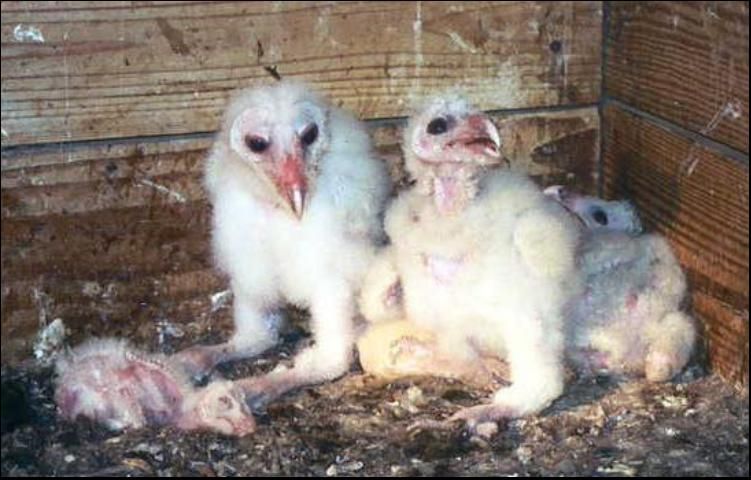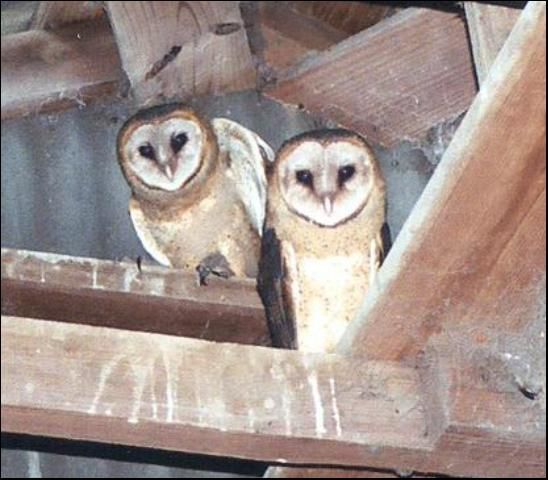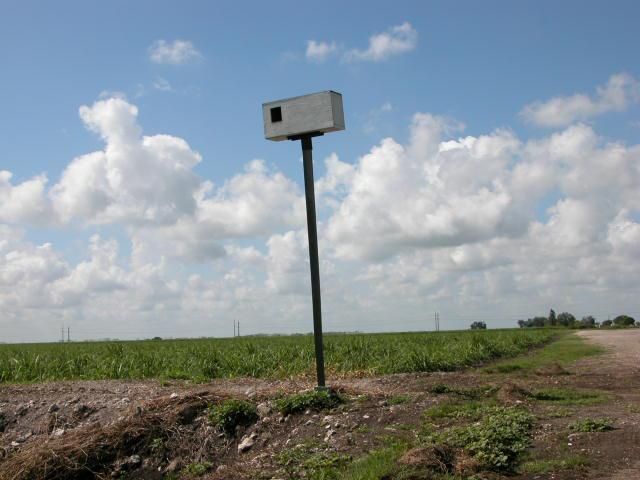Barn owls, members of the family Tytonidae, are unmistakable nocturnal birds of prey. Their ghostly appearance and blood-curdling shriek have led to their incorporation into folklore and myth and have earned these birds a variety of nicknames, including "ghost owl" and "monkey-faced owl." Thirty-six subspecies have been identified worldwide. The subspecies that lives in North America is called Tyto alba pratincola.
Identification
Barn owls have a white or tan underside with black spotting. Males tend to be whiter and have less speckling than females (Figure 1). The wings are long and ornately colored with shades of brown, tan, black and white. Barn owls have a distinctly heart-shaped, white facial disk and lack ear tufts that are characteristic of many other owl species. Their eyes are dark and relatively small when compared to other owls. They have long legs that are easily seen when they are roosting or flying overhead. Female barn owls tend to be slightly larger than males. On average, females measure 34–40 cm (13.4–15.7 inches) in length and weigh 570 g (1.3 lbs), and males are 32-38 cm (12.6–15.0 inches) long and weigh 470 g (1.0 lbs).

Credit: Jason Martin
Hunting and Diet
Barn owls hunt using their excellent low-light vision and hearing. Their facial disk funnels sound into their ear holes, which are located beneath the feathers on each side of their face. These openings are slightly lopsided from each another. This allows the owls to sense how far away a sound is from them. Barn owls are so good at locating prey by sound that they can do so even when the prey is completely hidden from view.
Small mammals are the primary food of barn owls. Voles (Microtus sp.) are the most common prey in northern North America and Europe, although mice, shrews and moles also are eaten. In southern Florida, where no voles and few mice occur, larger rats, such as cotton rats (Sigmodon hispidus), roof rats (Rattus rattus), and rice rats (Oryzomys palustris) are eaten, along with small marsh rabbits (Sylvilagus palustris) and round-tailed muskrats (Neofiber alleni). Non-mammalian prey, including birds, amphibians, reptiles and large insects are occasionally consumed. Prey usually are swallowed whole, although large items are sometimes torn into smaller pieces before being eaten. Indigestible bones and fur are later regurgitated in the form of an "owl pellet." The diets of barn owls can be analyzed by examining the contents of these pellets.
Habitat and Nest Sites
Barn owls inhabit open areas, including agricultural fields, grasslands and marshes. They nest in hollow trees and in buildings where there is not much human activity. Barn owls also will use artificial nest boxes. Nests typically are located on the floor of the natural tree cavity or building (Figure 2). They are made with broken-down bits of old owl pellets. Nest sites are commonly reused by the original occupants or other pairs of owls. The availability of potential nesting sites limits barn owl abundance in some areas.

Credit: Jason Martin
Range
Barn owls have a global distribution. They are absent only from parts of the West Indies, Indonesia, and New Zealand, and seldom occur at extreme northern latitudes. Estimates of individual home ranges, which vary greatly, have been as large as 3174 ha (12.3 sq mi) and as small as 151 ha (0.6 sq mi). This variation probably is due to differences in habitat and prey availability. For example, if food is scarce in a particular area, an owl may have to travel long distances to get the amount of food that it needs to survive. It would have to hunt over a much smaller area if food is plentiful. The home ranges of neighboring barn owls can overlap significantly.
Behavior and Sociality
These owls are strictly nocturnal predators and spend the daylight hours resting, or "roosting," in quiet protected areas. Members of a pair frequently roost together. They usually do not actively defend their foraging territories from other owls, but they will defend the area immediately around their nests. If food resources are abundant, barn owls sometimes nest in close proximity to each other. For example, at least five pairs are known to nest regularly in a single barn in south Florida. When cornered, barn owls exhibit a variety of threat displays including wing spreading, head waggling, hissing, and bill snapping.
Reproduction and Development
Barn owls usually are monogamous and often remain with the same partner for several consecutive breeding seasons. Eggs are laid between February and June, depending on locality and climate. In Florida, eggs are usually laid in February. In subtropical and tropical areas, including southern Florida, a second set of offspring are produced in the late summer or fall. The average number of eggs produced is 4–6, but extremes of more than 10 eggs in a single nest have been observed. Eggs are laid 2 or 3 days apart and hatch in that same sequence. As a result, there is always an age difference of a few days between each chick (Figure 3). This ensures that at least a few of the chicks, because they are older and stronger, will always be fed if food becomes scarce. If food is plentiful, all of the chicks will be able to eat. Chicks grow rapidly, achieving adult weight and feathering in 8–9 weeks (Figure 4). At this point they roost near the nest while learning to fly and hunt. Their parents still bring food to them for another few weeks until they become fully independent.

Credit: Jason Martin

Credit: Jason Martin
Conservation Status
Barn owl populations are stable in some parts of their range, including Florida, but seven midwestern states list barn owls as threatened or endangered. Nine other states classify them as a species of concern. Population declines also have been noted in Europe. The most often cited cause of these declines has been the loss of nesting and roosting sites resulting from changing agricultural practices and urbanization. As agriculture has increased in scale and modern farming techniques implemented, many open-air barns and other farm buildings have disappeared from the landscape. Rows of trees that were once a common feature in small-scale agriculture also have been removed, further degrading barn owl habitat. Additionally, the expansion of urban areas into pastoral countrysides has destroyed owl hunting and nesting habitat. The use of pesticides may have impacted many owl populations by indirectly poisoning them or by killing off their food source. The relative importance of these factors in the overall decline of the species is unknown.
The loss of nesting sites may be offset by installing artificial nest boxes (Figure 5). Barn owls will readily occupy these structures if they are provided. The preservation of large trees and the maintenance of open, grassy areas also would be beneficial for these owls. Furthermore, reduced use of pesticides would minimize the risk of accidental poisoning of barn owls.

Credit: Jason Martin
Selected References
Florida Fish and Wildlife Conservation Commission. 2003. Florida's Breeding Bird Atlas: A Collaborative Study of Florida's Birdlife. http://www.wildflorida.org/bba
Lee, C.H. 1997. Barn owl for field rat control in cocoa. Journal of Tropical Agriculture and Food Science 25(1):43–54.
Marti, C.D. 1992. Barn owl. In The Birds of North America – Life Histories for the 21st Century (A.F. Poole, P. Stettenheim and F.B. Gill, eds.). The American Ornithologists Union and The Academy of Natural Sciences of Philadelphia, Washington, D.C. and Philadelphia. Pp. 5–15
Taylor, I. 1994. Barn Owls: Predator-Prey Relationships and Conservation. Cambridge: University Press. 304 p.
Van Vuren, D.; Moore, T.G.; and Ingels, C.A. 1998. Prey selection by barn owls using artficial nest boxes. California Fish and Game 84(3):127–132.